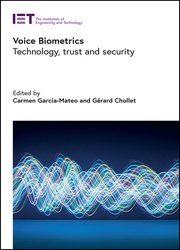Voice Biometrics: Technology, trust and security
- Добавил: literator
- Дата: 18-08-2021, 13:14
- Комментариев: 0
 Название: Voice Biometrics: Technology, trust and security
Название: Voice Biometrics: Technology, trust and securityАвтор: Carmen García-Mateo, Gerard Chollet
Издательство: The Institution of Engineering and Technology
Год: 2021
Страниц: 300
Язык: английский
Формат: True EPUB
Размер: 10.1 MB
Voice biometrics are being implemented globally in large scale applications such as remote banking, government e-services, transportation and building security access, autonomous vehicles, and healthcare. They have been integrated in numerous apps, often coupled with face biometrics and artificial intelligence methods. Voice biometrics products and solutions must meet three key requirements for the success in their deployment: they must be highly trustable regarding privacy protection; easy to use and always be available.
This edited book presents the state of the art in voice biometrics research and technologies including implementation and deployment challenges in terms of interoperability, scalability and performance, and security. The team of editors and chapter authors combine a wealth of expertise from academia and the industry. Topics covered include the fundamentals of voice biometrics; design of countermeasures for replay attack; attacker's perspective for voice biometrics; voice biometrics; speaker de-identification; performance evaluation of voice biometrics solutions; standardization of voice biometrics technology; industry perspectives; joining forces of voice and facial biometrics; and future trends and challenges in voice biometrics.
Neural networks, sometimes also called artificial neural networks (ANN), are algorithms for machine learning that consist of a set of units (neurons), which are usually grouped in layers (known as hidden layers) and connected by some weights. This topology allows the model to transform the input data in such a way that it is able to find useful patterns to perform a specific task such as classification or regression. The process of adjusting the values of the connections (weights) is known as training. The currently very popular DNNs are then a type of neural network whose topology is composed of several hidden layers, in contrast to shallow architectures with just one hidden layer. With that configuration, DNNs are able to extract features at different levels of abstraction and they also have the ability to learn complex non-linear transformations of the input directly from the available dataset for the target task.
Due to their use in speaker recognition, we would like to briefly describe the main ideas under two topologies: convolutional neural networks and long short-term memory recurrent neural networks (LSTM-RNNs). First, convolutional neural networks are very popular models with a slightly different topology from the previously described DNNs. These models have been applied successfully for speaker recognition and have shown their ability to model speech signals for other tasks as well, such as speech or language recognition. They provide a relatively low computational cost algorithm with respect to other DNNs, since their configuration usually reduces the number of parameters of the model.
Providing comprehensive coverage of the field of voice biometrics, this authoritative volume will be of great interest to researchers, scientists, engineers, practitioners and advanced students involved in the fields of security, biometrics, forensic sciences, human computer interaction, speech processing, acoustics, multimedia, pattern recognition, and privacy-preserving, digital signal processing and speech technologies. It will also be of interest to researchers and professionals working in law and criminology.
Скачать Voice Biometrics: Technology, trust and security
Внимание
Уважаемый посетитель, Вы зашли на сайт как незарегистрированный пользователь.
Мы рекомендуем Вам зарегистрироваться либо войти на сайт под своим именем.
Уважаемый посетитель, Вы зашли на сайт как незарегистрированный пользователь.
Мы рекомендуем Вам зарегистрироваться либо войти на сайт под своим именем.
Информация
Посетители, находящиеся в группе Гости, не могут оставлять комментарии к данной публикации.
Посетители, находящиеся в группе Гости, не могут оставлять комментарии к данной публикации.
